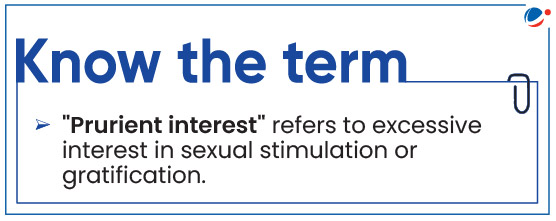Introduction
The Supreme Court, while hearing a case on obscene remarks in the India's Got LaTent show on YouTube, urged the Solicitor General to propose regulatory measuresto curb vulgar content online while balancing free speech.
Also, the Ministry of Information and Broadcasting (I&B) warned OTT (Over-The-Top) platforms against transmitting "any content that is prohibited by law", and urged them to follow age-based classification as per the Information Technology (Intermediary Liability and Digital Media Ethics Code) Rules, 2021. Platforms were also directed to enforce age-gating requirements for mature content.
About Obscenity
The term 'Obscene' is used to describe those things which are either disgusting to the senses or offensive to an individual in a sexual manner whereby they aim to incite lust in a person.
Key Stakeholders for content Streaming on Digital Platforms.
Key Stakeholders | Associated interest |
Content Creators & Artists |
|
Digital Platform |
|
Government & Regulatory Bodies |
|
Society at large |
|
Need for Regulating Obscenity on Digital Platforms

- Preserving Social and Cultural Values: Allowing unchecked obscene content weakens moral character, fostering disrespect and moral decay.
- E.g., The 2021 "Bulli Bai" app incident, where images of women of a minority community were auctioned online, exposed the misuse of social media to target and humiliate women, prompting calls for stricter regulation.
- Protecting Human Dignity: Kant asserts that humans must never be treated as mere means to an end. Content that reduces people to objects of prurient interest violates the core principle of dignity and personal autonomy.
- Avoiding Normalization of Obscenity: The Harm Principle (by John Stuart Mill) suggests that freedom of expression should not cause harm to society.
- Regular exposure to obscene content can desensitize individuals, eroding empathy and reinforcing harmful stereotypes.
- Ethical Responsibility of Platforms: Utilitarianism suggests that actions should promote the greatest good. Digital Platforms are thus, ethically mandated to ensure content balances free speech with societal well-being, fostering a safe digital environment.
- Upholding Constitutional Morality: Constitutional morality safeguards core values such as social justice and equality, ensuring that digital content aligns with these principles.
- Article 19 (2) establishes that the fundamental rights of freedom of speech and expression is not absolute and reasonable restrictions could be put on such rights on various grounds including public order, decency, morality, incitement to an offense, among others.
Ethical Issues in Regulating Obscene Digital Content
- Vagueness and Subjectivity of Obscenity: Senior Advocate Dushyant Dave highlighted that decency and morality vary over time and across regions. While the language in India's Got Latent was inappropriate, it may not meet the legal definition of a crime, as such speech is common in everyday discourse in society.
- Censorship vs. Reasonable Restrictions: While laws protect morality, over-regulation could stifle creativity. Since obscenity is subjective and evolving, excessive restrictions could limit diverse perspectives in media.
- E.g., The 2024 ban of 18 OTT platforms by the Ministry of I&B for "obscene and vulgar" content was criticized as arbitrary, with some arguing it stifled creative expression.
- Evolving Social Norms and Cultural Sensitivity: Obscenity is a cultural construct that changes over time. Ancient Khajuraho and Konark temples feature erotic sculptures, yet today, such expressions might face censorship.
- Power Dynamics: Questions arise about who decides what content is acceptable, with the risk of censorship being weaponized against marginalized communities.
- Agency and Paternalism (Interference with personal autonomy): There's an ongoing tension between protecting users from harmful content and respecting their autonomy to make their own content choices.
- Excessive regulation may infantilize users, assuming they cannot make informed decisions about the content they consume.
- Regulating Obscene vs. Artistic Freedom: Tension between censorship to protect public morality and freedom of artists to express themselves creatively.
- E.g., In Maqbool Fida Hussain v. Raj Kumar Pandey case, court ruled that nudity alone does not constitute obscenity, highlighting ethical dilemma between artistic expression and societal norms.
Conflict between Ethics and Law of Banning Content with ObscenityThe conflict between legal restrictions on obscenity and evolving ethical standards presents a complex challenge in Indian jurisprudence. This conflict emerges from several key factors: Legal Framework Without Clear Definition
Evolving Judicial Interpretation
Above all, the increasing trend of filing multiple FIRs for the same offense has been criticized as a form of harassment that unfairly prejudices the accused and undermines their right to a fair defense. While content that offends public sensibilities may invite criticism or boycotts, excessive legal action risks infringing on freedom of expression. |

Way ahead
- Justice & Objectivity: Define clear and consistent obscenity guidelines that consider India's cultural diversity to avoid bias or subjective judicial rulings.
- Accountability & Responsibility: Introduce a Broadcasting Bill to regulate OTT content, digital news, and emerging technologies, ensuring ethical and socially responsible media.
- Encouraging Ethical Content Creation: To ensure social responsibility & cultural sensitivity, promote self-regulation and ethical storytelling that reflects societal values and cultural respect.
- Empowerment & Informed Choice: Implement digital literacy programs to educate youth on media ethics, responsible viewing, and online safety.
Conclusion
Obscenity is highly subjective, varying across cultures and time. Therefore, creating a responsible digital media space requires legal clarity, self-regulation, public awareness, and global cooperation. By upholding ethical values such as justice, dignity, transparency, and accountability, digital platforms can strike a balance between creative freedom and social responsibility.
Check Your Ethical AptitudeWith the rise of obscenity and profanity on digital platforms, the Supreme Court has directed the Solicitor General to propose measures to curb "filthy language" and "vulgarity" in online content, emphasizing the need to balance freedom of speech with societal moral standards. In this context, answer the following questions:
|



